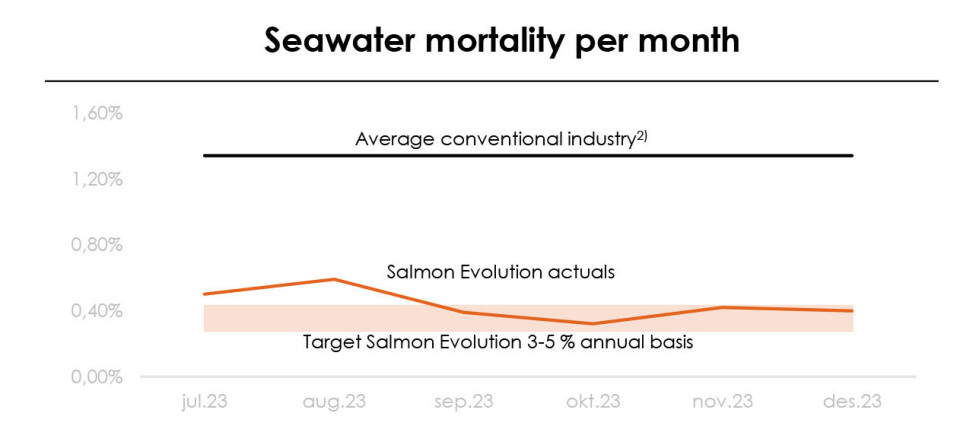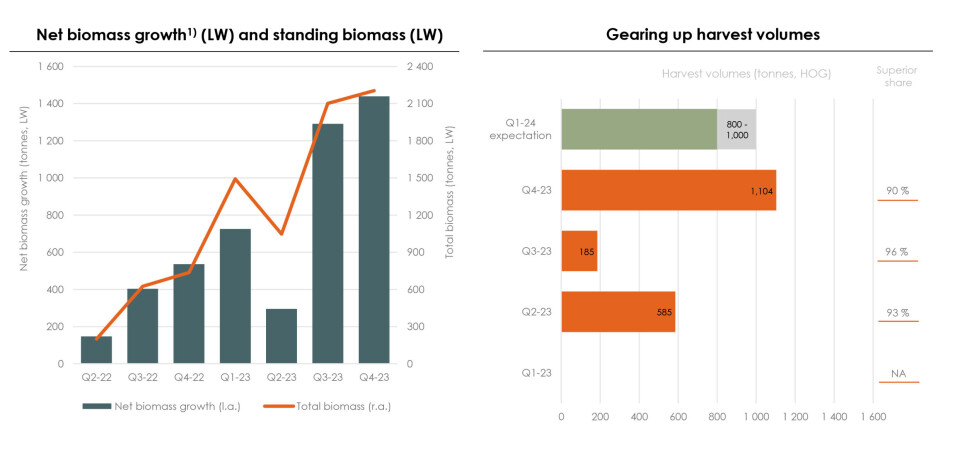
Salmon Evolution eyes significant increase in harvest volumes from Q2
Land-based salmon farmer well placed to profit from expected record prices
Land-based fish farmer Salmon Evolution ended 2023 with a historically high biomass in its facility on Indre Harøy island in Norway and record harvest volumes for a quarter.
According to a market update from the company, as of December 31, 2023, it had a standing biomass of more than 2,200 tonnes (live weight) and had an all-time high net biomass production of 1,439 tonnes (LW) in the quarter.
“The company continues to see a strong biological performance with good appetite and low mortality at Indre Harøy,” it stated.

Salmon Evolution harvested 1,104 tonnes (head on gutted) in the fourth quarter of last year, with a 90% superior share and tight weight concentration. The average weight was approximately 3.5 kilos. For the whole of 2023, it harvested 1,874 tonnes HOG.
The fish harvested in Q4 fetched an average price of NOK 76 per kilo (including transport and downgrades), which reflects that most of the volume was harvested in November.
Batches 3 and 4, which were affected by an amoebic gill disease incident in Q2, have now been fully harvested. According to the company, this has affected the harvest weights and the superior share somewhat.
Increasing harvest weights are also expected in the future.

“The market background at the start of 2024 is very attractive with expected record high salmon prices. Salmon Evolution is well positioned to benefit from this on the basis of a significant increase in slaughter volumes in the coming quarters, as the facility at Indra Harøy will then be fully utilised,” said chief executive Trond Håkon Schaug-Pettersen in a comment.
Harvest volumes in the first quarter of 2024 are expected to be in the range of 800-1,000 tonnes (HOG), which, together with further build-up of biomass, will lay the foundation for a significant increase in harvest volumes from Q2 onwards.
Superior share
It is also pointed out that we are entering a time of year that is usually associated with several downgrades for the industry and that Salmon Evolution expects to benefit from its high superior share when it comes to price achievement going forward.
Approximately 75% of batch 5 remains for harvest in Q1 after one of the groups was pushed to Q1 to optimise harvest weights and price realisation.
Salmon Evolution’s ninth batch of smolts was stocked in October and batch 10 partly stocked in December, with the rest of the smolts to be put in early this month.
“Operations at the smolt plant were affected by challenging weather conditions prior to the transport of smolt for batch 10, which somewhat reduced the original input volumes. This is not expected to have a major impact on 2024 biomass production or harvest volumes,” said the company.






















































